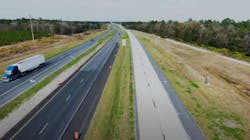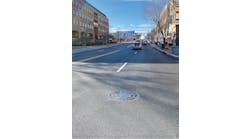Over 4 miles of road on U.S. Route 31 near Jacksonville, Florida is a testing ground for the first high-tech concrete experiment in the Sunshine State.
The $27 million project is being funded and researched by the Florida Department of Transportation (FDOT) in order to test concrete pavement and base design. FDOT engineers are able to monitor pavement conditions in real-time under live traffic.
“The pavement has embedded strain gauges and thermocouples to measure pavement response to load and temperature continuously,” said Michael Williams, deputy communications director at FDOT in an interview with Transport Topics.
According to Williams, the road will be evaluated “twice a year with several pieces of equipment to measure the pavement smoothness, amount of cracking, friction resistance and texture of the pavement surface, pavement profile, noise generated from the pavement and stiffness of the different pavement layers.”
FDOT Secretary Jared Perdue said, “Using innovative technologies to collect real time data on the efficacy of various types of concrete available to use on Florida’s roads allows us to use the most effective materials to create resilient transportation corridors and reliable supply chains while prudently using taxpayer dollars. The more resilient the materials we use, the longer they last, reducing our maintenance costs and construction times, limiting the congestion travelers feel in active work zones.”
The concrete at the beginning of the test area has technology providing daily traffic volume measurements, according to Howie Moseley, state materials engineer at FDOT.
“The vast majority of the time, all the traffic on 301 going toward Jacksonville will be able to drive right over the concrete test road,” Moseley said.
FDOT is conducting some basic road studies and is is looking at different pavement designs, including varying pavement thickness from 6 to 10 inches. Engineers are also evaluating several different types of concrete pavement bases.
“The goal is to determine the most optimal way to design a concrete pavement, and we’ll use this information to refine our design procedures, our construction specifications and also our maintenance procedures for concrete pavements,” said Moseley.
U.S. Route 301 was picked because of the high volume of traffic, lack of crossroads, and businesses through the route.
---------------------------------------------------------------
Source: Transport Topics



